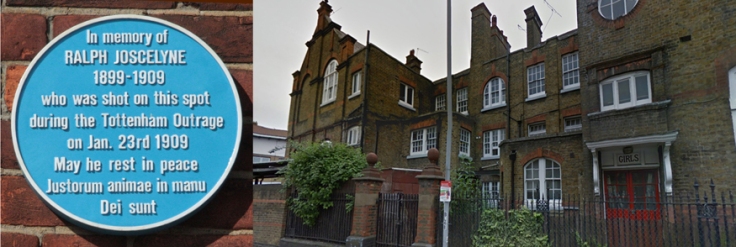In the 1830s, the problem of burying the dead had reached crisis point in London. The rapidly increasing population meant that existing graveyards and crypts were – literally, in some cases – full to bursting. One such example was the nightmarish Enon Chapel in Clement’s Lane. An unscrupulous clergyman had come up with a scheme for bargain burials. These may have been at a knock-down price, but they were not burials. The body of your loved one would simply be tipped into the crypt below the chapel, to join countless others. The enterprising minister was also of accused of recycling the wood from the coffins to sell to the poor for kindling. The crypt was only separated from the chapel above by a flimsy wooden floor, through which all kinds of noxious gases and vile insects would pass, to plague the worshipers as they sat down in the pews to praise the Lord. Even more bizarre was the conversion of the chapel to a dance hall, where customers could literally dance on the dead.

Eventually, the authorities decided that enough was enough, and began the business of commissioning seven huge new cemeteries outside if the inner city boundaries. Highgate and Kensal Green are the best known of these, principally due to the numbers of famous people buried within, but it was to one of the lesser known of ‘The Magnificent Seven’ that I traveled, on a pilgrimage to visit the graves of two people who certainly made the headlines in their day, but are largely forgotten now.

You can read the story of The Tottenham Outrage elsewhere on the site but, briefly, on Saturday 9th January 1909, two Latvian anarchists ambushed the wages delivery for the Schnurmann Rubber Factory on Chestnut Road in Tottenham and made off with the loot, firing at their pursuers with sophisticated automatic pistols. Both criminals died as a result of their efforts, but a policeman and a young boy were killed in the chaotic chase.
The cold blooded murder of PC William Tyler caused a national outcry, and his funeral was a public event on a grand scale. The deaths of police officers in the course of their duties have always been thought shocking in Britain and, happily, they remain rare events. PC Tyler was laid to rest in Abney Park Cemetery in Stoke Newington. Fortunately for the visiting explorer, his simple but imposing memorial is near the path, and is easily found. The number carved on the pediment is, of course, his police number.

Just a few feet away from Tyler’s grave is a rather humbler cross which marks the grave of an even more tragic casualty of the madness of 9th January 1909. Like countless others before and since, young Ralph Joscelyne had a Saturday job. His was to help a local baker deliver bread to the families in that part of Tottenham. As the Latvian gunmen tried to shoot their way to safety, a stray shot hit Ralph as he tried to hide behind his employer’s cart in Mitchley Road. The ten year-old was cradled in the arms of a bystander, but was pronounced dead by the time he reached hospital.

On 29th January 1909, the funeral cortège for Joscelyne and Tyler passed along a 2.5 mile route lined by 3,000 police officers and an estimated crowd of 500,000. The lengthy procession included white-plumed horses drawing Joscelyne’s coffin and black-plumed horses drawing Tyler’s coffin, draped in a Union Flag, which were escorted by hundreds of policemen, a police band, men from the local fire brigade, men from the Scots Guards and Royal Garrison Artillery, and tramway employees. A volley of guns was fired at the conclusion of the funeral.

 Ralph Joscelyne’s mother, Louise, was to raise another seven children, but she kept the pair of boots Ralph was wearing on the day he was killed. When she died in 1952, the boots were buried with her. In more recent times, both Joscelyne and Tyler have been commemorated. WIlliam Tyler has a plaque on the wall of Tottenham police station, while Ralph Joscelyne is remembered in a memorial outside a church in Mitchley Road. There is an abiding irony that the corner of Tottenham where the robbery occurred and the resultant chase began is exactly where the catastrophic riots of 2011 started. An initially peaceful protest by relatives of Mark Duggan, a gangster shot by police, did not get the required response from officers within the police station. It then, as they say, “all kicked off.”
Ralph Joscelyne’s mother, Louise, was to raise another seven children, but she kept the pair of boots Ralph was wearing on the day he was killed. When she died in 1952, the boots were buried with her. In more recent times, both Joscelyne and Tyler have been commemorated. WIlliam Tyler has a plaque on the wall of Tottenham police station, while Ralph Joscelyne is remembered in a memorial outside a church in Mitchley Road. There is an abiding irony that the corner of Tottenham where the robbery occurred and the resultant chase began is exactly where the catastrophic riots of 2011 started. An initially peaceful protest by relatives of Mark Duggan, a gangster shot by police, did not get the required response from officers within the police station. It then, as they say, “all kicked off.”
Ralph’s memorial in Abney Park was paid for by fellow scholars at his school, Earlsmead, which still stands in Broad Lane, Tottenham (below) and distant relatives of the unfortunate lad have, as mentioned earlier, ensured that his death will not be forgotten against the backdrop of more recent troubled times in London.

According to some Tottenham residents, however, the boy has not completely left us. This, from the pages of a local newspaper:

 (Left) The spot where Ralph Jocelyne was killed, then and now.
(Left) The spot where Ralph Jocelyne was killed, then and now.
 Oak Cottage, where the Tottenham Outrage ended, has long gone, but a ‘a then and now’ picture reminds us of what it looked like. It would have stood to the right of the existing pub, which is called The Royal Oak.
Oak Cottage, where the Tottenham Outrage ended, has long gone, but a ‘a then and now’ picture reminds us of what it looked like. It would have stood to the right of the existing pub, which is called The Royal Oak.










